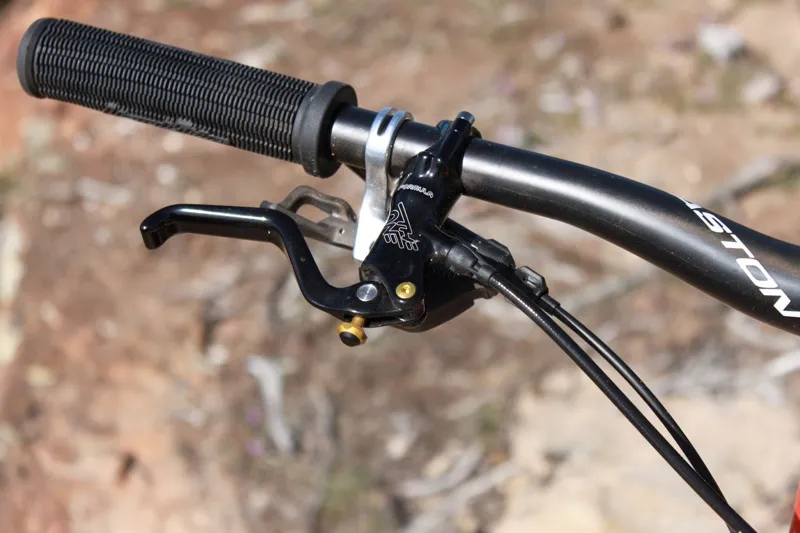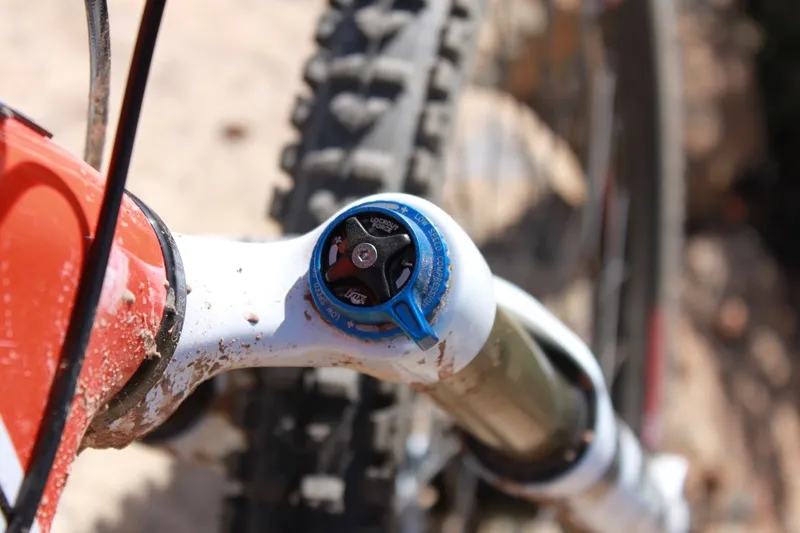Splitting the difference between the Blur XC and LT, Santa Cruz’s new 5in-travel Blur TRc (Trail Carbon) pairs cross-country weight — 4.9lb (2,222g, claimed) for the medium frame — with a progressive modern trail geometry to create an incredibly versatile, fun to ride, play bike. Given the chance it'll win over all types of riders — they may just need to open their minds a slight bit.
The TRc's defining feature is that it has a 1° slacker head tube than most of its competitors with similar travel. Paired with a custom Fox F series RLC fork with 130mm of travel, the head angle works out at 68° – the same as that of the Blur LT, but in a shorter travel package. Less travel, however, isn’t the only difference between the TRc and LT; the two sport different overall geometries.
The new model falls in line with Santa Cruz's ‘endurance’ fit, as found on the Blur XC, Nickel, Superlight, Tallboy and Highball models. This manifests as a considerably longer top tube and cockpit. The LT has more in common with the more compact ‘all-mountain’ side of the line, such as the Butcher and Nomad. A medium TRc sports a 23in top tube, while a medium Blur LT's is 22.5in long.

The TRc combines the weight and fit of the Blur XC with the slacker geometry of the Blur LT, at a suspension travel that splits the difference
Ride & handling: Playful and stable at speed, if a little slow on switchbacks
While the TRc is as light as many manufacturers' cross-country bikes, it’s rated for a 140mm-travel fork and to be ridden as such. According to Santa Cruz, the frame is built to be trail-bike tough. Based on the bike’s weight — 25.33lb (11.49kg) with XTR XC component kit, RockShox Reverb seatpost and XT pedals — pedaling characteristics and suspension travel, it’s hard to imagine anyone wouldn’t like to ride it. However, its progressive geometry will likely put a few people off.
We can guarantee you'll like the TRc if your riding is dominated by buff, steep or fast trails. The bike's stability is impressive and its feel only seems to get better with speed. Aggressive riders already accustomed to slack trail and downhill bikes who are looking for a lightweight chassis to trail ride or even race cross-country with will find it ideal. We’ve found that once a rider learns how to ride a slacker bike it becomes harder and harder to ride a bike with steeper angles. The extra stability seems to far outweigh the detrimental effect on slow speed handling.
Conversely, those whose rides are dominated by tight, bar-width singletrack over technical terrain with slow average speeds will likely prefer something steeper and inline with the cross-country norm. This type of rider will also likely notice the TRc’s slightly lower-than-average 13.1in bottom bracket height and experience more frequent pedal strikes.

The Blur TRc’s VPP design uses a carbon upper swing link and an alloy lower link
Our first rides on the TRc spanned a variety of terrain that showed both the bike’s strengths and weaknesses. We sliced up flowy singletrack using lots of body English, which produced a smile ear to ear. Likewise, we muscled the thing around tight switchback corners on Gooseberry Mesa outside Hurricane, Utah, puckered, at less than walking speed; in these instances we made it happen, but it would have been much easier on a steeper bike.
The VPP suspension performed well and we never noted any sort of pedaling feedback, though we didn’t spend too much time in the small chainring, where issues would have been most apparent. Downhill performance is very good. We were able to run slightly more sag, and subsequent negative travel, than average without detriment to the pedaling performance. We used all the travel, without harsh bottoming. However, we didn’t push the limits of the bike in terms of drop height, maximum speed or overly aggressive trail features.
Within the first five minutes on the bike, its light weight, stiffness and wonderful seated pedaling manners were immediately apparent and impressive. The Blur TRc doesn't weigh much on the scales, and rides like it's even lighter. It sprints up hills, all the while begging for you to use every feature of the terrain as a playground. It’s a fun bike to ride that’s also supremely versatile; we can even see ourselves racing cross-country on it — just for fun, of course.

The Blur TRc will be offered in two colors: matte black and green (pictured) and gloss black and orange
Frame: Efficient carbon construction maximizes strength and weight
With the introduction of the latest Blur XC three years ago, Santa Cruz launched their first carbon fibre model and the construction process that has now infiltrated the entire line. The carbon manufacturing is carried out in China with an unnamed partner who doesn't share the co-developed process with any other mountain bike manufacturers, according to the Californian company.
The main tenet of the process is using a shaped mandrel that allows the frame’s carbon layers to be placed precisely and stretched, so that it’s under tension even before the molding bladder is pressurized. The difference in pressure between the initial stretch and bladder pressurization is described as the “difference between touching and pushing on something” by Nick Anderson, Santa Cruz’s design engineer.
“It takes two people working together two hours to get a bike into a mold,” said Michael Ferrentino, Santa Cruz’s marketing manager, about the process. “It’s a very laborious, very carefully monitored process that requires a lot of precision.” The payoff is excellent consistency and better precision in terms of material placement, which means the carbon plies are placed precisely according to the engineer’s design. As a result, the finished product maintains the attributes modeled in FEA and tested in the lab. “It allows the most efficient layup,” said Anderson.

This cutaway shows the precision and different types of carbon used in the different areas of the frame; notice how the down tube features a thicker lower wall and thinner upper wall.
The only metal in the bike is the lower shock linkage, threaded bottom bracket shell, faceable grommets for the carbon rear brake mount and threaded suspension mounts, and the glued-in cable and water bottle bosses. The frame is finished with a stainless steel chain strike plate, for chain suck, and rubberized chain- and seatstay protectors that sit in a groove molded into the chassis.
The TRc features the same second generation VPP design found on all of Santa Cruz's higher-end suspension bikes. Launched with the current generation Blur LT, it has a flatter shock rate than the original system and a reduced chain growth figure of 16mm. New for the TRc — and the Tallboy aluminum — is an asymmetric lower linkage that allows for better fitment of a bottom bracket mounted chain guide and grease ports on the linkage that are better protected from damage. If they do break, replacement is easier due to a new thread design, versus the press fitment of old.
Our only disappointment with the TRc frame comes from its incompatibility with SRAM's narrowest 156mm Q-factor XX crank, which we'd like to have seen as an option given the possibility that riders will use this frame for cross-country racing.

The Blur TRc has rubberized guards on the chain- and seatstays that fit within molded pockets in the frame
Equipment: High-end component package highlights this bike's strengths
Our test bike featured Santa Cruz’s XTR XC component kit along with Fox’s custom F 32 RLC 130mm fork and RP23 rear shock. The component package combines top-of-the-line components from Easton, Formula and Shimano, but you do pay a premium: complete, it costs US$6,493, and that's without the RockShox Reverb height adjust post we tested with.
We’ll go on record and recommend that everyone who buys the TRc adds a dropper post. It’s well worth it and exponentially adds to the fun factor. Shimano’s new 30-speed Dyna-Sys transmission drives Santa Cruz’s top-spec group and it performed flawlessly during our test, although in the slow technical terrain of Gooseberry Mesa we could have easily gotten away with a double chainring as opposed to the specced triple.
Formula’s The One brakes offered stellar feel and power, which was especially firm at the lever (we love that), but we weren’t able to adjust the reach in as far as we'd have liked using the tool-free adjuster; it bottomed out before our preferred setting. Considering we have medium hands, this will likely be an issue for those with short fingers.

Formula's The One brake offered impressive feel and power, but lacked close-in reach adjustment and was tough to fit with a remote (seatpost or shock) lever
We also had a hard time getting all of our controls to mesh well on the handlebar. The Formula brakes have a radial master cylinder, which — especially when forced to contend with the addition of a remote lever for a height-adjust seatpost or shock lockout — make it challenging to get the brake lever and shift levers in the right spot.
Santa Cruz build a noteworthy custom wheelset for their top-level kit, which is comprised of The Hive’s Chub 15/20 front hub, which conveniently converts between the two through-axle standards via end caps, paired with a DT Swiss 240s IS disc rear hub, DT XR400 (tubeless convertible) rims and DT Competition 14/15 butted spokes and alloy nipples. The wheels are laced three-cross and provide good stiffness with what should be excellent durability and repair-ability, but are admittedly skewed more towards cross-country racing than something wider, tougher and worthy of a true ‘trail’ designation.

The Chub front hub is both 15mm and 20mm through-axle compatible via replaceable end caps
Santa Cruz wrap the wheelset in Maxxis CrossMark 2.1in tires, which work well in dry cross-country conditions — in the rear — but limit the bike overall. We wholeheartedly recommend a 2.35in High Roller or something of the like for the front of the bike. If you put something that size on the rear you’ll definitely add more aggressive capability to the bike.
The XTR XC kit is finished with an Easton EA90 alloy stem, 685mm EC70 carbon bar, Thompson Masterpiece seatpost and WTB Silverado saddle. Handlebar and stem proved rock solid. The Thompson post is beautiful, strong and light, but as we’ve said, the TRc ‘requires’ a dropper post. As for the saddle, we found the flat Silverado’s edges dropped off too abruptly for our butts, which seemed to focus a lot of weight right on our sit bones and became detrimental to comfort after two hours or so.












